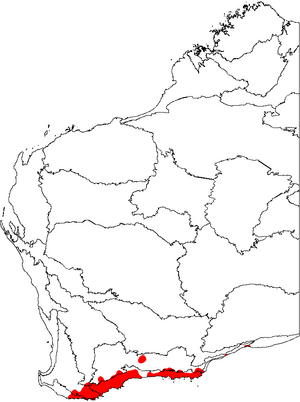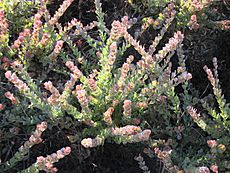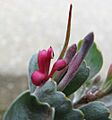Coastal jugflower facts for kids
Quick facts for kids Coastal jugflower |
|
|---|---|
 |
|
 |
|
| Scientific classification | |
| Genus: |
Adenanthos
|
| Species: |
cuneatus
|
| Synonyms | |
|
|
The Adenanthos cuneatus, also known as the coastal jugflower or flame bush, is a type of shrub. It belongs to the Proteaceae plant family. This plant grows naturally along the south coast of Western Australia.
A French scientist named Jacques Labillardière first described this plant in 1805. The Adenanthos cuneatus is part of the Adenanthos group of plants. It is most closely related to another plant called A. stictus. This plant can also mix with other Adenanthos species to create new types of plants called hybrids.
The Adenanthos cuneatus can grow up to 2 m (6 ft 7 in) tall and wide. It can stand upright or spread out low to the ground. Its leaves are shaped like a wedge and have fine, silvery hairs. The plant has small red flowers that appear all year, but especially in late spring. New reddish leaves grow during the summer.
This plant needs sandy soil and good drainage to grow well. This is because it is sensitive to a plant disease called Phytophthora cinnamomi dieback. Its natural home is sandy heathlands. Many animals help pollinate its flowers. These include bees, honey possums, silvereyes, and honeyeaters. The western spinebill bird is especially fond of it. People grow A. cuneatus in gardens in Australia and the western United States. You can even find special dwarf and low-growing types for sale.
Contents
What it Looks Like
The Adenanthos cuneatus is a shrub that can grow upright, spread out, or lie flat on the ground. It can reach up to 2 m (6 ft 7 in) tall and wide. This plant has a woody base called a lignotuber. This base helps it regrow after a bushfire.
Its leaves are wedge-shaped, which means they are wider at the tip and narrower at the base. They are about 2 cm (0.8 in) long and 1–1.5 cm (0.4–0.6 in) wide. Each leaf has 3 to 5 (sometimes up to 7) rounded "teeth" or lobes at its end.
New leaves are red and a bit see-through. They glow bright red when light shines through them, especially when the sun is low. Most new growth appears in summer. The leaves are covered with fine, silvery hairs.
The flowers are small and dull red. They are about 4 cm (1.6 in) long. You can see them throughout the year, but more often from August to November.
How it is Different from A. stictus
The Adenanthos cuneatus looks a lot like its close relative, A. stictus. The main difference is how they grow.
- A. cuneatus usually has many stems and a lignotuber. It rarely grows taller than 2 m (6 ft 7 in).
- A. stictus has a single stem and no lignotuber. It often grows up to 5 m (16 ft 5 in) tall.
Their leaves are similar, but the lobes (the "teeth") on A. cuneatus leaves are regular and rounded. On A. stictus leaves, the lobes are irregular and more toothed. Also, new growth on A. stictus is not red. Young leaves of A. stictus are usually much bigger than adult leaves, which is not true for A. cuneatus. The flowers of both plants are very similar.
Plant History and Names
How it Was Found and Named
We don't know the exact time or place where Adenanthos cuneatus was first found. However, it was likely collected by Jacques Labillardière. He was a botanist (plant scientist) on an expedition led by Bruni d'Entrecasteaux. Their ship stopped at Esperance Bay in Western Australia on December 9, 1792.
Labillardière probably found the plant on December 16. He was looking for a zoologist (animal scientist) named Claude Riche, who had gone missing. Labillardière convinced the expedition leader to search for one more day. This led to finding Riche and also collecting several important plant samples. These included the first samples of Anigozanthos (Kangaroo Paw) and Nuytsia floribunda (West Australian Christmas Tree), and of course, A. cuneatus.
It took 13 years for Labillardière to officially describe A. cuneatus. During that time, other scientists also collected samples. Robert Brown collected one in 1801. Jean-Baptiste Leschenault de La Tour and Antoine Guichenot collected more in 1803.
Labillardière finally published the name of the plant group Adenanthos in 1805. He also described A. cuneatus and two other species. He chose the name cuneata because the plant's leaves are wedge-shaped (triangular). Later, a botanist named E. Charles Nelson chose A. cuneatus as the main example for the Adenanthos group. This was because Labillardière's description of it was the most detailed.
Common Names
This plant has several common names. Some are used only in certain places.
- Bridle bush is a name used east of Esperance. It means horses like to eat it as fodder.
- Sweat bush is used around Hopetoun. People say horses sweat after eating its young leaves.
- Flame bush comes from its bright red new leaves.
- It is also known as coastal jugflower.
Where it Grows and Lives

The Adenanthos cuneatus is the most common Adenanthos plant along the south coast of Western Australia. It grows in many places between King George Sound and Israelite Bay. You can find it along the coast and up to 40 km (25 mi) inland. Some groups of these plants are also found further west near Walpole and the Stirling Range. They can also be found as far east as Twilight Cove.
This plant only grows in sandy soils that contain a lot of silica (like quartz sand). It will not grow in soils with a lot of limestone. This is why it's found in specific spots east of Israelite Bay. There, you can find cliff-top dunes with deep sandy soil, which is perfect for it. As long as the soil is sandy and quite dry, A. cuneatus can grow in different soil types. It grows in sandy soils from both lateritic areas and marine areas. It can also handle different soil pH levels, from 3.8 to 6.6.
A. cuneatus is a common plant in the kwongan heathlands. These are open shrublands often found on the sandy plains of Southwest Australia. The climate in these areas is Mediterranean. This means it has hot, dry summers and mild, wet winters. The area gets between 275 to 1,000 mm (10.8 to 39.4 in) of rain each year.
How it Interacts with Nature
Bees from the genus Leioproctus visit the flowers of Adenanthos cuneatus. Studies have shown that the honey possum (Tarsipes rostratus) sometimes visits Adenanthos cuneatus flowers. The western spinebill bird prefers these flowers over others. The New Holland honeyeater and white-cheeked honeyeater also help pollinate it. The silvereye bird (Zosterops lateralis) drinks nectar from the flowers. It has also been seen drinking dew drops from the leaves in the morning.
Adenanthos cuneatus can get a plant disease called Phytophthora cinnamomi dieback. This disease can cause the plant to die. However, some studies say it's not very susceptible, while others say it is. One study found that A. cuneatus populations were not greatly reduced in areas affected by this disease.
Growing it in Gardens
Adenanthos cuneatus was brought to Great Britain in 1824. People now grow it in gardens in Australia and the western United States. Its pretty bronze or reddish leaves are a main reason to grow it. It also helps attract birds to gardens.
This plant needs soil that drains water well to grow successfully. It can grow in full sun or partial shade. It also tolerates both sandy and gravelly soils. A nurseryman from Western Australia, George Lullfitz, suggests growing it as a spreading ground cover in front of other shrubs or in a rock garden.
Here are some special types (cultivars) of Adenanthos cuneatus:
- A. "Coral Drift" is a compact type. It has been grown since at least the 1990s. It grows 50–70 cm (19.7–27.6 in) tall and 1–1.5 m (3.3–4.9 ft) wide. Its grey leaves have new growth that is pinkish-purple.
- A. "Coral Carpet" is a type that grows low to the ground. It reaches about 20 cm (7.9 in) high and spreads 1.5 m (4.9 ft) wide. Its new leaves are pinkish-purple. This type grew from a random seedling of 'Coral Drift'. George Lullfitz developed it. It became available in 2005.
Images for kids
-
Red new growth of A. cuneatus in Torndirrup National Park.
See also
 In Spanish: Adenanthos cuneatus para niños
In Spanish: Adenanthos cuneatus para niños




